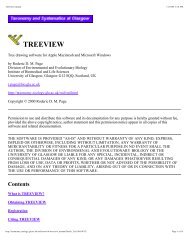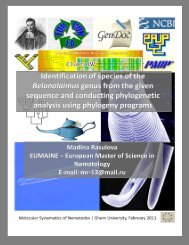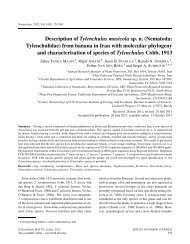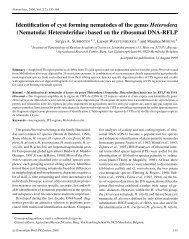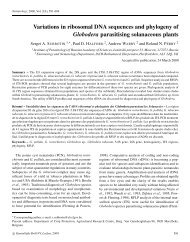Morphological and molecular characterisation of Californian species ...
Morphological and molecular characterisation of Californian species ...
Morphological and molecular characterisation of Californian species ...
Create successful ePaper yourself
Turn your PDF publications into a flip-book with our unique Google optimized e-Paper software.
S. Álvarez-Ortega et al.<br />
DIAGNOSIS AND RELATIONSHIPS<br />
This <strong>species</strong> is characterised by its body 1.54-1.96 mm<br />
long, lip region <strong>of</strong>fset by deep constriction <strong>and</strong> 17-<br />
19 μm broad, odontostyle 17-19 μm long with its aperture<br />
occupying 70-74% <strong>of</strong> its length, neck 415-539 μm long,<br />
pharyngeal expansion 213-275 μm long or 49-53% <strong>of</strong><br />
total neck length, uterus simple <strong>and</strong> 27-41 μm long<br />
or 0.6-0.8 times the corresponding body diam., uterine<br />
eggs granulate, pars refringens vaginae with two well<br />
developed sclerotised pieces, vulva transverse (V = 48-<br />
51), tail conical (35-44 μm, c = 39-52, c ′ = 1.4-1.6) with<br />
its inner core notched <strong>and</strong> nearly reaching the tip, <strong>and</strong><br />
male unknown.<br />
The new <strong>species</strong> resembles M. mombucae, a poorly<br />
characterised <strong>species</strong> (see above), from which it can be<br />
distinguished by being generally smaller (L = 1.54-1.96<br />
vs 1.83, 1.99-2.34 mm), the relatively longer neck (b =<br />
3.6-4.2 vs 4.2-5.2), shorter female tail (35-44 vs 50-<br />
60 μm, c = 39-52 vs 30-36) <strong>and</strong> <strong>of</strong> different shape<br />
(ventrally straight vs slightly curved ventrad), <strong>and</strong> male<br />
absent (vs present). It is also similar to M. marinensis<br />
sp. n. in its general morphology, but it differs from this<br />
in its broader lip region (17-19 vs 14-15 μm), longer<br />
odontostyle (17-19 vs 13-15 μm), shorter uterus (27-41<br />
vs 201-262 μm long, or 0.6-0.8 vs 3.7-4.7 corresponding<br />
body diam.) <strong>of</strong> simpler construction (vs tripartite), more<br />
anterior vulva (V = 48-51 vs 55-58), <strong>and</strong> male unknown<br />
(vs as frequent as females).<br />
MOLECULAR CHARACTERISATION<br />
Two sequences, 758 <strong>and</strong> 759 bp long, <strong>of</strong> the D2-D3<br />
region <strong>of</strong> the 28S rDNA gene were obtained.<br />
On the identity <strong>and</strong> the taxonomy <strong>of</strong><br />
Metaporcelaimus<br />
HISTORICAL OUTLINE<br />
Lordello (1965, see also 1967) proposed Metaporcelaimus<br />
with the new <strong>and</strong> only <strong>species</strong> M. mombucae from<br />
Brazil, <strong>and</strong> classified it under the Dorylaiminae de Man,<br />
1876 <strong>of</strong> the Dorylaimidae de Man, 1876, regarding it as<br />
close to Aporcelaimus Thorne & Swanger, 1936. As originally<br />
defined, the most distinguishing feature <strong>of</strong> Metaporcelaimus<br />
when compared to Aporcelaimus was the<br />
pharynx morphology (Introduction).<br />
Heyns (1965) created the family Aporcelaimidae to<br />
group two genera transferred from Dorylaimidae, namely<br />
Aporcelaimus <strong>and</strong> Sectonema Thorne, 1930, as well as<br />
four new genera: Aporcelaimellus Heyns, 1965, Aporcelaimoides<br />
Heyns, 1965, Makatinus Heyns, 1965 <strong>and</strong><br />
Scapidens Heyns, 1965. Heyns originally conceived his<br />
new family to be mainly characterised by its large size,<br />
thick cuticle, lip region <strong>of</strong>fset by constriction, odontostyle<br />
with large aperture or a mural tooth as stomatal protruding<br />
structure, guiding sheath without a sclerotised fixed ring,<br />
female genital system didelphic-amphidelphic, <strong>and</strong> tail<br />
similar in both sexes. Metaporcelaimus was not considered<br />
by Heyns due to the coincidence in time <strong>of</strong> the publication<br />
<strong>of</strong> that genus <strong>and</strong> his monograph. Siddiqi (1969)<br />
overlooked the existence <strong>of</strong> Metaporcelaimus in his revised<br />
classification <strong>of</strong> Dorylaimoidea.<br />
Lo<strong>of</strong> & Coomans (1970) erected Aporcelaimium Lo<strong>of</strong><br />
& Coomans, 1970, with A. labiatum (de Man, 1880) as<br />
its type <strong>and</strong> only <strong>species</strong>, this being transferred from<br />
Eudorylaimus. The new generic taxon was characterised,<br />
among other features, by the location <strong>of</strong> S 1 N: S 1 N 1<br />
closer to DN than to S 1 N 2 , <strong>and</strong> it was separated from<br />
Aporcelaimellus “by the shape <strong>of</strong> the vulva (a transverse<br />
slit), <strong>and</strong> in the thin outer cuticle layer; also by the low<br />
value <strong>of</strong> K”.<br />
Tjepkema et al. (1971) also overlooked the existence<br />
<strong>of</strong> Metaporcelaimus in their revision <strong>of</strong> Aporcelaimellus,<br />
but concluded that (p. 50) “the relationship between<br />
Aporcelaimellus, Aporcelaimus, <strong>and</strong> Aporcelaimium also<br />
is in need <strong>of</strong> additional study”.<br />
Andrássy (1976) considered Metaporcelaimus as a junior<br />
synonym <strong>of</strong> Aporcelaimellus but regarded Aporcelaimium<br />
as valid. Jairajpuri & Ahmad (1992) followed<br />
Andrássy’s criteria <strong>and</strong> distinguished Aporcelaimium from<br />
Aporcelaimellus by the nature <strong>of</strong> the cuticle (inconspicuous<br />
vs conspicuous layering) <strong>and</strong> location <strong>of</strong> the pharyngeal<br />
gl<strong>and</strong> nuclei (S 1 N 1 closer to DN than to S 1 N 2 vs S 1 N 1<br />
closer to S 1 N 2 than to DN). Lo<strong>of</strong> et al. (1995) formally<br />
transferred M. mombucae to Aporcelaimellus.<br />
Andrássy (2001, 2009; see also Vinciguerra, 2006) restored<br />
Metaporcelaimus, regarding Aporcelaimium as its<br />
junior synonym. Metaporcelaimus was mainly characterised<br />
by the “shape <strong>of</strong> labial region <strong>and</strong> stylet, the arrangement<br />
<strong>of</strong> oesophageal gl<strong>and</strong> nuclei <strong>and</strong> the shape<br />
<strong>and</strong> length <strong>of</strong> tail”, <strong>and</strong> it was compared with Aporcelaimellus<br />
<strong>and</strong> Aporcelaimus. As established by Andrássy<br />
(2001), Metaporcelaimus might differ from Aporcelaimellus<br />
in eight morphological features: i) more slender body;<br />
ii) cuticle structure (inner layer homogeneous under light<br />
microscope vs divided into two distinct sub-layers with<br />
different refraction <strong>of</strong> light, especially expressed on tail;<br />
12 Nematology



